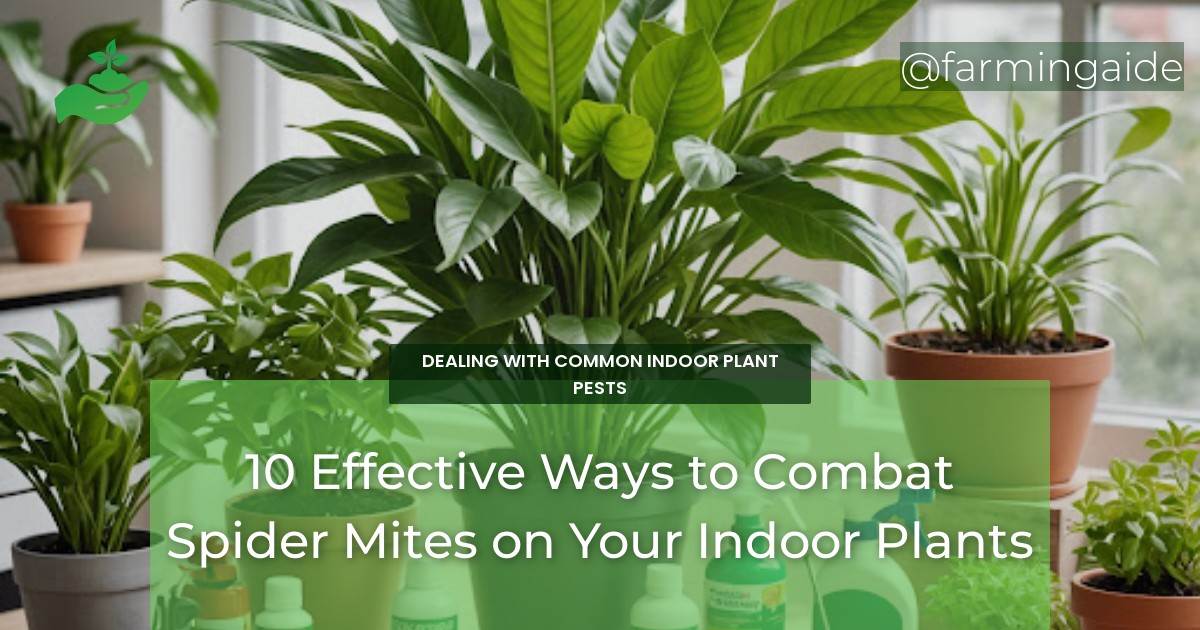Are you tired of dealing with pesky spider mites on your beloved indoor plants? These tiny, eight-legged pests can wreak havoc on your green friends, causing yellowing leaves, premature defoliation, and even plant death if left unchecked. But fear not, dear plant enthusiast! With the right knowledge and strategies, you can combat spider mites and keep your indoor plants thriving.
Key Takeaways
- Understand the life cycle and habits of spider mites to effectively combat them.
- Implement preventive measures to create an environment inhospitable to spider mites.
- Natural remedies like neem oil and beneficial insects can be effective in controlling spider mite infestations.
- Chemical control options like insecticidal soap and miticides can be used in severe cases.
- Physical removal techniques and post-treatment care are crucial in restoring plant health.
Understanding Spider Mites
Before we dive into the various methods of combating spider mites, it’s essential to understand their life cycle and habits. Spider mites are tiny, spider-like insects that feed on plant sap, causing damage to leaves and stems. They thrive in warm, dry environments and can reproduce rapidly, making them a formidable foe for indoor gardeners.
Spider mites are most active during the summer months, and their life cycle typically consists of four stages: egg, larva, nymph, and adult. Adult spider mites can live for up to four weeks, laying hundreds of eggs during their lifetime. This rapid reproduction rate makes it crucial to address infestations promptly.
Identifying Spider Mites
Identifying spider mites can be a challenge, as they’re barely visible to the naked eye. However, there are a few telltale signs of an infestation:
- Yellowing or bronzing of leaves
- Fine webbing on plant surfaces
- Tiny, moving dots on the underside of leaves
If you suspect a spider mite infestation, carefully inspect the underside of leaves and stems for signs of activity.
Life Cycle of Spider Mites
The life cycle of spider mites typically consists of four stages:
| Stage | Description | Duration |
|---|---|---|
| Egg | Female spider mites lay eggs on the underside of leaves | 3-4 days |
| Larva | Larvae emerge from eggs and begin feeding on plant sap | 2-3 days |
| Nymph | Larvae molt into nymphs, which continue to feed and grow | 2-3 days |
| Adult | Nymphs molt into adult spider mites, which begin the cycle anew | Up to 4 weeks |
Preventive Measures
Preventing spider mite infestations is always better than trying to combat them after they’ve taken hold. Here are a few preventive measures you can take to create an environment inhospitable to spider mites:
One of the most critical factors in preventing spider mite infestations is maintaining an ideal indoor plant environment. This includes:
ALSO READ
Ideal Indoor Plant Environment
Spider mites thrive in warm, dry environments. By maintaining a humid, cool environment, you can make your plants less appealing to these pests:
- Maintain a humid environment (50-60% relative humidity)
- Keep temperatures between 65-75°F (18-24°C)
- Provide adequate air circulation around plants
Regular Inspection Routine
Regularly inspecting your plants for signs of spider mite activity can help you catch infestations early, making treatment more effective:
- Inspect plants weekly for signs of spider mite activity
- Monitor for yellowing leaves, fine webbing, and tiny, moving dots on the underside of leaves
Natural Remedies
For small to moderate infestations, natural remedies can be an effective and environmentally friendly way to combat spider mites:
ALSO READ
Using Neem Oil
Neem oil is a natural insecticide that can be used to control spider mite populations:
Mix neem oil with water according to the label instructions and spray it on the affected plants. Repeat every 3-4 days to ensure efficacy.
Introducing Beneficial Insects
Certain beneficial insects, like ladybugs and lacewings, prey on spider mites and can be an effective biological control method:
Introduce beneficial insects into your indoor garden, and they’ll help keep spider mite populations under control.
Chemical Control Options
In severe cases of spider mite infestations, chemical control options may be necessary. Always follow the label instructions and take necessary safety precautions when using pesticides:
Insecticidal Soap
Insecticidal soap is a mild pesticide that can be used to control spider mite populations:
Mix insecticidal soap with water according to the label instructions and spray it on the affected plants. Repeat every 3-4 days to ensure efficacy.
Miticides
Miticides are specialized pesticides designed to control mite populations:
Follow the label instructions and take necessary safety precautions when using miticides.
Physical Removal Techniques
In addition to chemical control options, physical removal techniques can be an effective way to combat spider mites:
Washing Plants
Gently wash the affected plants with a strong jet of water to dislodge spider mites:
Repeat every 3-4 days to ensure efficacy.
Pruning Infested Parts
Prune infested leaves or stems to remove spider mite habitats:
Dispose of pruned material carefully to prevent re-infestation.
Post-Treatment Care
After treating a spider mite infestation, it’s essential to provide post-treatment care to restore plant health:
Restoring Plant Health
Provide optimal growing conditions, including adequate light, water, and nutrients, to help your plants recover from the infestation:
Monitor your plants closely for signs of stress or disease, and take prompt action if necessary.
Monitoring for Recurrence
Regularly monitor your plants for signs of spider mite activity to prevent re-infestation:
Take prompt action if you notice any signs of spider mite activity, and repeat the treatment process as necessary.
Conclusion and Summary of Spider Mite Control Strategies
Combating spider mites on indoor plants requires a multi-faceted approach, including understanding spider mite biology, implementing preventive measures, using natural remedies, chemical control options, physical removal techniques, and post-treatment care. By following the strategies outlined in this article, you’ll be well-equipped to tackle spider mite infestations and keep your indoor plants thriving.


